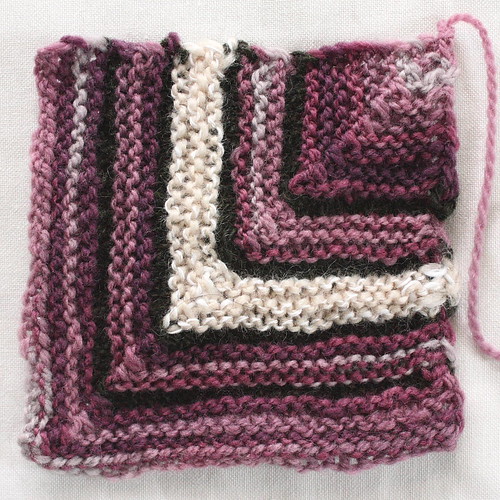
If you live in my part of the world (the Northern temperate zone) and you've spent any time in the garden or park this week, there's a good chance you can guess what inspired this square. Wanna try? The colours are perfect. Even the garter stitch pattern took me by surprise, evoking petals. If only you could smell it! but unfortunately I couldn't work fragrance into the thread. Now that aroma, in a bottle, would be a wonderful thing to pull out of the cupboard on a dreary February day, but at least I will have this square to remind me of my favourite flowering shrub. Oops, that slipped out. By now you should be getting the picture.
The first six squares and stories in this blanket seemed to follow a sentimental path. Maybe I should explore the darker side of yarn, but I could only go where the fibre and my senses led me; where life itself carried me. The death of a friend began to change the tone.
Since then a particular theme has begun to suggest itself every time I root through my stash to find material for the next square. Perhaps this season causes it. Every story that comes to mind relates to nature, our environment, how we're looking after our earth or failing to do so, what will become, and how we might improve the prospects. Will this story blanket become an environmentalist rant?
We are in the midst of the Holocene extinction event, one of the most severe declines in biodiversity that has occurred in Earth's history, and it is entirely caused by human activity. A 1998 study by the American Museum of Natural History found 70 per cent of biologists believe one-fifth of all living populations will become extinct by the year 2028.
Environmentalists usually try to drive home this message (and the one about climate change) and inspire social action by pointing out that this problem threatens our own existence, and that is true. Our actions might harm the biosphere so radically as to render it uninhabitable.
Actually it is more a question of responsibility to other organisms that share this place. How long will we continue believing the world was made for us, it's all about us, and that happiness can be derived from as much as we can take? Admittedly I tend to live indulgently, too, and it won't be easy to stop. Maybe the best thing that could happen to our planet would be if our acquisitive species wiped itself out. Selfishness is bred into our genetic code. Biology didn't consider these limitations when it invented itself.
What does this have to do with lilacs? Because yes, lilacs inspired this square. I went looking for yarn and found exactly what I imagined at Guelph's new fibre boutique, All Strung Out: this hand-dyed confection called "Berry Smoothie" from Lofty Fibres. The creator might have been thinking of fruit, but I saw something else.
An abandoned homestead, its inhabitants long dead and buildings reduced to rubble, still surrounded by a rambling host robed in pink, white and magenta, shedding heaven's fragrance over the graves. Such visions are not hard to find around marginal Ontario farmland. Syringa vulgaris, the common lilac, originated in the Balkan peninsula, but has adapted well to growing conditions in Ontario. It is hardy, frequently becoming naturalized and surviving after other relics of human habitation have disappeared. A few minutes from my apartment, a trail following the Eramosa River upstream passes through a thicket of lilacs covering several hectares. They're probably descended from a hedge that lined the drive to a farmhouse a century ago. I call it Lilac Way, and throughout the year savour memories of May pilgrimages along that path.
At Royal Botanical Gardens in Burlington, Ontario, the annual lilac celebration (Quicktime movie) continues this weekend, May 30 and 31, at one of the world's largest collections of lilac cultivars.
In the midst of habitat loss, exotic species take over from rare indigenous treasures. Many of these—starlings, rats and cockroaches—seem to make the world a duller, less savoury place.
But I can't help cherishing the indestructible lilac. It gives me hope that whatever happens to this world, beauty will survive whether or not we are here to perceive it. After we are dead, I do not doubt these shrubs will carry on shedding radiance and sweetness. It is in their nature.
This might sound sentimental again, but hope is a valuable weapon in the war against apathy. Find something, whatever inspires you, and go with it.


The square is beautiful! I knew immediately that it was inspired by lilacs. Here in Florida lilacs don't do very well...dogwoods don't either and both are on the top of my "favorites" list. I am enjoying your blog and looking through your work. I also checked out "Queer Joe's." The men's retreat looks like a wonderful time of community.
ReplyDeleteI read your response to Danny Gregory's note and am impressed with what you had to say. Thanks for sharing your ideas.
Frankye (female person!)
Frankye, thanks for your comment! It's exciting to hear from a new reader in this new blog, so I hope you will revisit from time to time. I have posted a new entry this morning.
ReplyDeleteI was fortunate to attend the men's knitting retreat in 2008, and it was an incredible time. I enjoyed meeting Queer Joe and a number of other fun and inspiring men. You can read about my experience in my other blog, here and here.
Lilacs are among my most favourite of flowers (them and dandelions, actually). I knew immediately that's what inspired this square! I've been enjoying reading these tales and am so glad you're doing this!
ReplyDelete